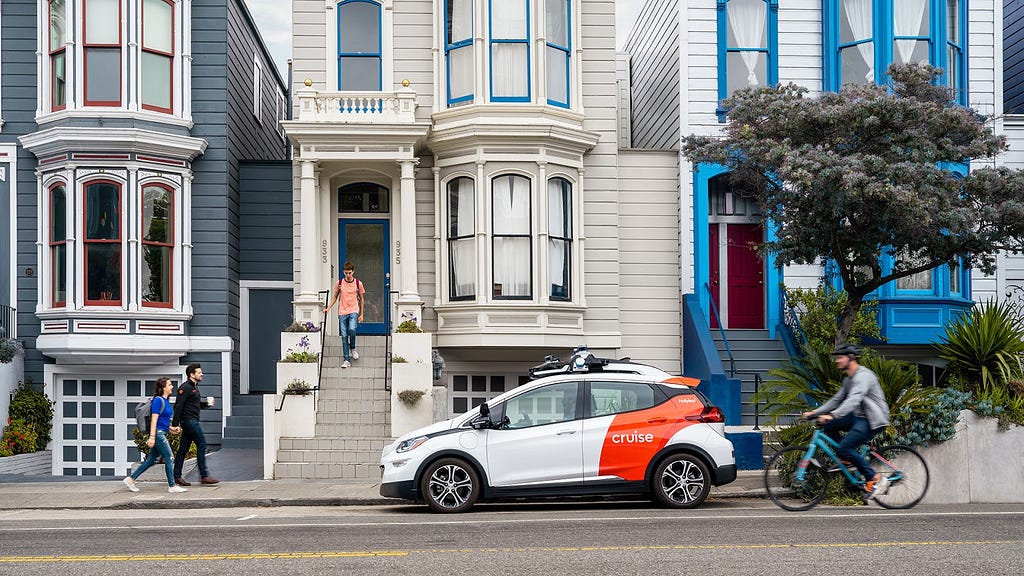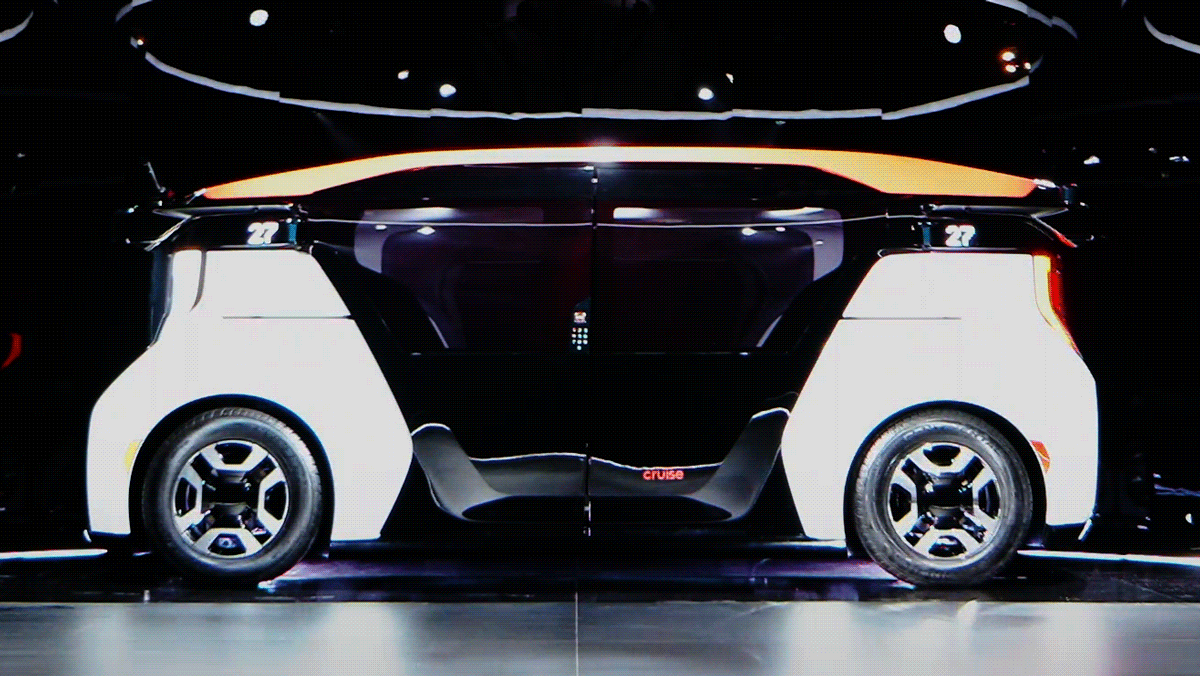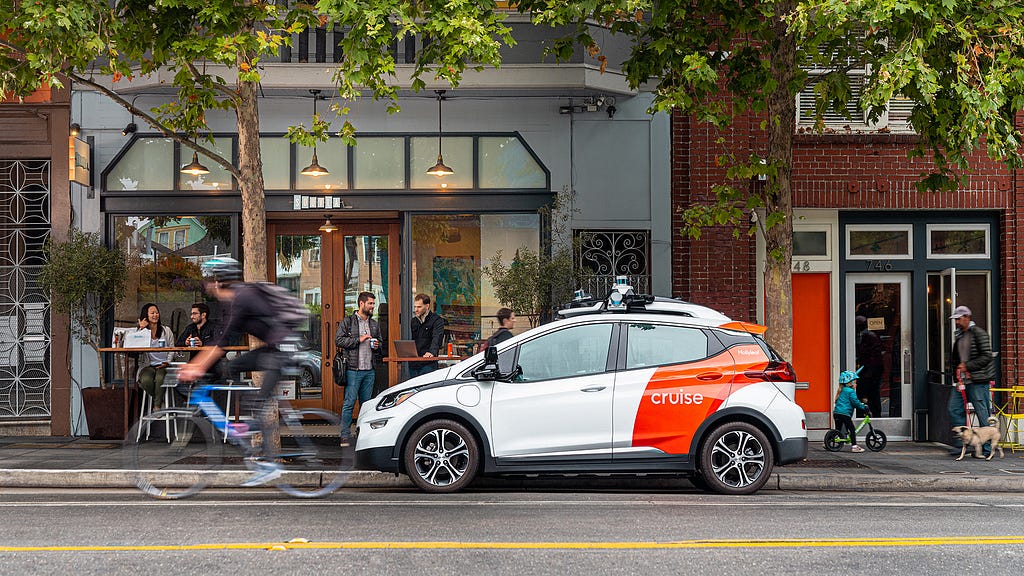Every day, Cruise autonomous vehicles drive through San Francisco as we prepare to launch our self-driving service. Here’s why we’re doing it, and why you should be excited.

Six weeks after my brother welcomed his first child into the world, he made a human mistake: he used the wrong bicycle brake while going downhill when he hit a speed bump. This caused him to fly over the handlebars, breaking both his elbows.
As devastating as this was, he’s lucky his accident wasn’t worse. California has the highest number of cyclist fatalities in the United States, with 98% of crashes involving motor vehicles. Still, changing diapers at 2 am is a lot harder when you can’t bend your arms. It was hard on my brother and harder on his wife.
When you step back and think about it, why do we continue to accept a world that human drivers — and their mistakes — have made so dangerous? Every 15 minutes, someone in the US dies in a car crash. 94% of car crashes are caused by human error — and that’s just the start of the problems from human-driven, gas-powered cars. Despite all our efforts to keep our kids from smoking, we breathe air in cities that is equivalent to smoking hundreds of cigarettes a year. We chase youth endlessly, and yet we never reconsider the two years of life we spend driving a car. And finally, we accept that close to half of all Americans have no access to public transportation.
We’ve built all the cities, power grids, and highways at this point. The thought of starting over and designing a city for the next century is overwhelming. It would be challenging for any agency or government organization to completely overhaul our cities’ infrastructure in a radical form.
At Cruise, we’re motivated to do our part to solve these problems, one self-driving vehicle at a time. As we make decisions about the product we’re building, we ask ourselves the question, “Will this solution help us partner with people to drive life in cities forward?”. If we can answer yes, then we figure out how to build it.
Driving life forward is a big statement that can be open to interpretation. At Cruise, we focus ourselves by asking if our product design choices will:
- Help save millions of lives by reducing car crashes
- Reshape cities around people, not cars
- Give people time to do things other than drive
- Make transportation more accessible for all
If our solutions help advance these definitions of “life”, then we pursue them. If not, we don’t build them.
In our guiding question, we also mention partnering with people and cities. We believe that we’ll only change the cities we live in if our solution is used by billions of people around the world. By designing a solution that people want to use, we’ll change our cities by tapping into people’s natural habits. We can’t drive the change we want if we don’t create something that people love more than what they have today.
We also are laser focused on cities. By 2050, the Earth will have close to 3 billion more people than we have today. All of this population growth will happen in cities. If you thought congestion, air quality, and traffic were bad today, you haven’t seen anything yet.
Here’s a peek at how we’re doing it.
Cruise will save millions of lives by reducing car crashes
Cruise will create safer transportation by replacing the primary factor that causes crashes: humans. 94% of car crashes are caused by human mistakes like speeding, fatigue, distraction, or drunk driving.
In the future, you’ll ride in self-driving vehicles made by Cruise that will never get tired, distracted, or drink and drive. They will always see what’s happening around them, literally, with state-of-the-art sensors that create a 360-degree view of the world. Imagine seeing in every direction, simultaneously. No blind spots. These sensors will help prevent unnecessary collisions, like a cyclist getting hit by a door because a driver didn’t look over their shoulder before opening it. Transportation will be safer for everyone, not just drivers.
We’re designing for the future now, building features in our vehicles and rider platforms that will deliver on this promise. For example, because our vehicles drive themselves, we don’t need all of the things you normally need for human drivers. In our new purpose-built vehicle called the Cruise Origin, we built doors that slide open versus hinge-ing out. This was only made possible in a vehicle design where we don’t have human drivers. We continue to discover new ways for self-driving vehicles to unlock solutions that make our roads safer. This simple vehicle design choice will keep our cyclists’ safe from getting hit by a door.

Cruise will reshape our cities for people
Let’s do some quick math: today, there are about 250 million vehicles in the US, and over a billion parking spaces. That means we’re devoting 4 parking spots worth of real estate per car. And those cars don’t move 96% of the time.
Cruise will vastly improve our city’s design by reducing the presence of cars.
Through truly shared vehicles that spend the majority of their lives in motion, we have the opportunity to reduce the number of parking spots by half. If we achieve our goal, we’ll create space for 100 million studio apartments, or 87 parks the size of the entire island of Manhattan. Fewer vehicles will also mean less traffic.
But perhaps the most important part of our environmental promise? Every Cruise vehicle is and always will be all-electric, emitting zero emissions. Most self-driving car companies have not made this hard decision. Given that every gasoline-powered car emits more than three times its own weight of CO² into the air each year, we believe our decision is crucial to the future of air quality in our cities. Fewer vehicles on the road and more of them emitting zero emissions is the way we’ll fundamentally improve the air quality and global warming caused by current gasoline-powered car emissions.
Cruise will give you back your time
The hour you spend driving to and from work equals 12 days a year stuck behind a wheel. That’s longer than the average vacation. What’s worse, commutes have only increased in the past decade due to increased traffic and population density.
In a Cruise self-driving vehicle, you’ll be hands-free and minds-free to do anything you’d like with that time. We’re adamant about getting to fully self-driving vehicles without drivers or assistants in the front seat. In a Cruise, you’ll be able to read to your kids, watch that TV show you missed, start your day with a clean inbox, or connect with that friend you haven’t seen in years. We want to give every person in cities 12 more days a year. Imagine what we collectively will be able to accomplish with that time back.
Cruise is designed for everyone
Many “super-commuters” travel up to 4 hours to get to work and back. They’re forced to follow a strict driving, bus, or train schedule, with few options being truly affordable. Ridesharing has been hailed as an equalizer, but when you consider that the cost per mile is up to 2.5 times more expensive than driving yourself (and meaningfully more expensive than public transportation), not everyone can access the service. Additionally, human drivers can make discriminatory choices, such as refusing to take trips to lower-income neighborhoods. In short, today’s transportation is deeply unequal.
Cruise vehicles are designed for inclusivity. They’ll never reject a pickup location because it’s inconvenient or because of the socioeconomic status of a neighborhood. Cruise will work 24 hours a day, seven days a week, and will not discriminate based on the race, color, and creed of our passengers. We’ll deliver first mile and last mile solutions that will augment public transit.
With Cruise, you, your family, and your friends will always have a way to get to where you need to go, no matter how far or late it is. At scale, everyone in cities will have access to this transportation system.
We’ll only change the world if people love using Cruise

All of us at Cruise have passion to redesign the way we move through our cities so we can truly improve the quality of life. Making our roads safer and our air cleaner while giving people more time and better access are transformational benefits.
At the same time, we know we’ll only achieve these world-changing benefits if people choose to adopt Cruise self-driving, all-electric, shared vehicles in lieu of human-driven, personally-owned, single-occupant cars.
To achieve this, we’ll need an experience that is a far superior ride at a much lower cost than today’s alternatives. To make Cruise work for people, it has to be fundamentally better than anything we enjoy currently.
Over the next few months, we’ll be publishing a series of blogs that will share more about how we’re designing products and experiences to deliver on our vision. Kyle and I founded Cruise to fundamentally make transportation better for all of us. The complexity of what we’re trying to solve is astronomical. At the same time, the impact we can have is what inspires us to bring our very best each day. We’re committed and we’re doing it.
Driving Life in Cities Forward, One Self-Driving Cruise at a Time was originally published in Cruise on Medium, where people are continuing the conversation by highlighting and responding to this story.